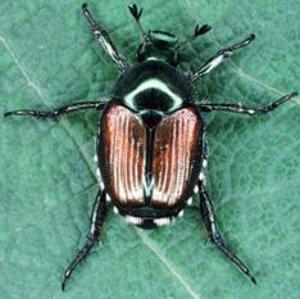Japanese beetles destroy thousands of plants each year in the United States and has been described as “one of the most destructive pests of lawns and gardens east of the Mississippi.” [Marinelli, p. 45] The Japanese beetle (Popilla japnica) was first noticed in the U.S. in 1916 in New Jersey. It has since spread from Ontario and Nova Scotia in Canada southward to Georgia and west to Tennessee and Missouri. Infestations of Japanese beetles have also been observed as far west as California. It is easily recognizable, being about one-half-inch in length, oval-shaped and metallic green with copper-colored wings. The larva (grub) is grayish-white and one-half inch to one inch long.
The grubs spend their winter in the ground, moving up to the roots of grasses in the spring to feed. The adults emerge in May and June, just in time to start munching on your favorite flowering perennials. (I have personally observed that Japanese beetles have never seen a hollyhock they did not like.) These adults feed on more than 200 species of plants and can quickly turn foliage into sad-looking skeletons and disfigure flowers. The females will lay eggs 30-45 days later in the soil, and the larvae will hatch within about 2 weeks. At that time, they will begin munching on the grass roots until cold weather arrives. (If you notice large patches of turf turning brown, you might very well have some Japanese beetle larvae.)
Some people think that setting beetle traps will help to rid their landscape of these destructive beetles; however, such traps tend to do more harm than good. They actually attract more Japanese beetles to your yard. Handpicking the adults from your plants is one of the best ways to control their spread. Mixing a few drops of dishwashing liquid with water and spraying your plants really helps, too, but you need to try to spray the adults directly with the mixture. To control the larvae, purchase commercially-available nematodes to feed upon the grubs. [See: Beneficial Insects to Buy for Your Garden.] Milky spore can also offer long-term control of the grubs. This is a bacteria that is specifically poisonous to Japanese beetle grubs and can be applied to large areas.
I have noticed that over the last few years, I have had very few Japanese beetles in my gardens. I might see one or two in a season. (It should also be noted that I do none of the things I have recommended in this article to control Japanese beetles. I have sprayed them in the past with dishwashing liquid and water but have had no need to do so for several years.) I contributed part of the reason that I have no Japanese beetles or very, very few to the fact that my husband and I have encouraged so many birds to visit our yard. Robins especially are good predators. I recently learned, however, that the herb tansy actually repels Japanese beetles. [For more information on this plant, see The Herb Tansy.] I have tons of tansy around my landscape. It has always been quite effective against mosquitoes, and now it seems that I can credit it for repelling Japanese beetles as well.
References:
Kowalchik, Claire and William H. Hylton, eds. Rodale’s Illustrated Encyclopedia of Herbs. Emmaus, PA: Rodale Press, 1998.
Marinelli, Janet, ed. Natural Insect Control: The Ecological Gardener’s Guide to Foiling Pests. Brooklyn, NY: Brooklyn Botanic Garden, Inc., pp. 45-6.



